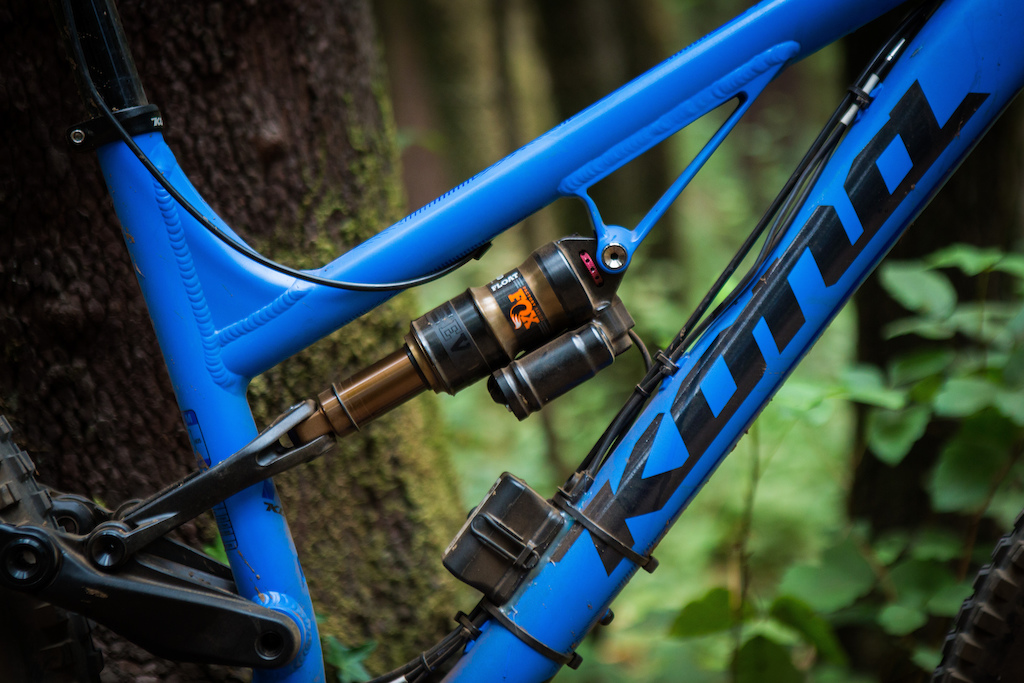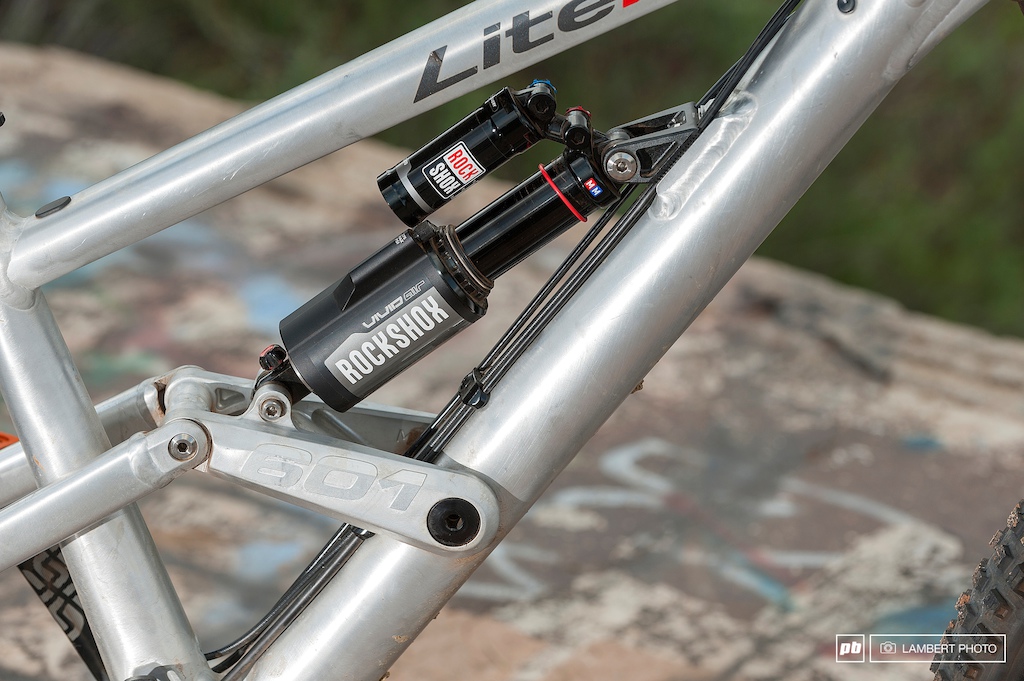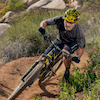Pinkbike Poll: Adjustable Geometry - Necessity or Nuisance?
Taken to the extreme, every aspect of your bike's geometry and suspension could be adjustable. Telescoping tubes, hinged steerers, slotted dropouts and eccentric bottom brackets are past innovations. Suspension flip chips, sliding shock mounts and offset bushings are nothing new, nor are forks with variable offset and travel options. You could buy a mountain bike based solely upon your favorite components, color, and frame material of the moment without sweating the numbers. Imagine, for instance, the Specialized Enduro of the future:
Once assembled with the wheel diameters you've selected, setting up your Specialized Enduro PGSHT (Personalized Geometry & Suspension Harmonizing Technology) would ensure perfection.
Once assembled with the wheel diameters you've selected, setting up your Specialized Enduro PGSHT (Personalized Geometry & Suspension Harmonizing Technology) would ensure perfection.
Doubt Medication and a Great Sales Tool
Somewhat closer to reality is that adjustable suspension and geometry devices are a form of mechanical medication. Self doubt sells. "Should I stick with what I know best, or should I buy into an emerging trend?" It's human nature to straddle the fence. That's why sliver SUVs are so popular.
Flip chips are powerful anti-anxiety pills for finicky customers and a wonderful sales tool for bike brands. "If you don't like long, low and slack, you can always return to familiar territory." Adjustable features assure timid buyers that expensive mountain bike purchase will be future proof.
Somewhat closer to reality is that adjustable suspension and geometry devices are a form of mechanical medication. Self doubt sells. "Should I stick with what I know best, or should I buy into an emerging trend?" It's human nature to straddle the fence. That's why sliver SUVs are so popular.
Flip chips are powerful anti-anxiety pills for finicky customers and a wonderful sales tool for bike brands. "If you don't like long, low and slack, you can always return to familiar territory." Adjustable features assure timid buyers that expensive mountain bike purchase will be future proof.
Flip chips allow bike brands to avoid risk of being first adopters. Geometry adjustments let bike makers lag safely behind the long low and slack curve until the movement had gathered enough momentum to eliminate financial risks. Not pointing fingers, but there's some conspicuous names proudly waving that flag today who missed the wedding.
Once You Know, You Don't Need It
"Pro racers are constantly changing their setups, right?" True that, but they're surrounded by experts and searching for one or two seconds from a bike that is near perfect. That's not us.
Granting the power to adjust your chassis doesn't automatically empower you to get it right. Candid conversations with bike demo technicians and and pro suspension tuners suggest that, while many riders have a working knowledge that can get their bikes in the ballpark, relatively few possess an accurate and comprehensive understanding of proper suspension tuning and bike setup.

Race teams and bike makers go to great lengths to understand and replicate suspension settings and kinematics. Subtleties that amatuer knob twisters largely ignore.
Those who score in that top ten percentile are also capable of choosing a bike with the correct suspension and geometry to suit their riding styles. They don't need flip chips. The rest of us probably have a fifty-fifty chance of getting it right so, providing the bike maker has a competent engineering staff, an argument could also be made that the absence of chassis adjustments would guarantee better than average performance.

Fox's Live Valve (prototype in this pic) dramatically simplifies high amplitude riding by reading the terrain and responding with just right pedaling and suspension control.
"Less-is-more" and "simpler is better" are becoming keynote marketing phrases. Bikes are pretty good across the board. Both trends suggest that the next wave of performance improvements may be strategies to reduce the complexity of our technology, while extending the useful range of the mountain bike's handling and suspension. Less dials and more smiles. That said, today's poll asks:
Author Info:
Must Read This Week
Sign Up for the Pinkbike Newsletter - All the Biggest, Most Interesting Stories in your Inbox
PB Newsletter Signup








Plus the execution is pretty clean and seems minimal maintenance and weight wise.
Angleset is what you want
If you don't live in an area where you can demo every bike on the market (or that just sounds like a costly pain in the ass... it does to me), having more options to dial in the bike or adapt it to different terrain if you're going on vacation to a totally different riding spot (for example) is awesome.
I'm also a massive fan of the modular / flip-chippy approach to frame design being adopted by Guerrilla Gravity, Intense, etc. Getting more geometry and wheel size options out of fewer molds and SKUs should allow for lots of options for customers and hopefully more wallet-friendly bikes in the long run.
Rocky's system allows for rider weight to factor in as well, so if you know your weight, you'll only be looking at 3 positions.
I only have one (mtb) bike, and want to do everything with it : freeride, enduro racing, bike park, xc marathon, bikepacking trip, etc..
I don't change it every day, but when I do something different from usual, I'll spend the 10mins I need to set up the bike accordingly.
Intense could have manufactured a 115mm and 130mm version, but that would cost them more, no?
but im with you the flip is kinda eh. i would like to have seen a new link to do 120 140 when they re did it to a 140 fork
I also think that single adjustments are useless because nothing works in isolation. If all you have is a shock flip chip to raise/lower the BB, you'll also be changing the head angle, reach, stack, and often the shock progression curve. In that scenario, and angle set headset could really help to bring the head angle back into line, then the bar/stem/spacers combo adjusted to correct for reach and stack.
I used to have an Altitude with RIDE-9. I left it in the slackest setting because the head angle was too steep (even in the slackest position), but sacrificed a good saddle position. I would have rather been in a mid position for a steeper seat angle, and less pedal strikes, then used an angle set to reduce the headtube angle with a longer travel fork to bring the stack height back to original.
Along the same lines, it might make the same bike design marketable to people in multiple different regions (more of the "set it up once" point you made) - I know east coast riders who def shy away from really low BBs and mega slack head angles, for example.
Then again, if the chip only changes HA and BB height by some trivial amount it doesn't really matter anyway. So it depends on how well it's implemented (obviously).
But, when I first got the bike, I did swap back and forth between the neutral and slack positions a lot (nice that Knolly made it so simple to do trailside... one bolt!!). Wanted to find out which position I preferred for most riding and what each position felt like, as well as strengths and weaknesses in both. Now I'm pretty much settled into keeping it in slack (and with the 160 fork, my head angle 64.
In the end, I agree, it's a nice to have, but isn't what ultimately sold me on the bike and is not a necessity.
"Self doubt sells. "Should I stick with what I know best, or should I buy into an emerging trend?" It's human nature to straddle the fence. That's why sliver SUVs are so popular."
I couldn't finish the article cause I don't understand this statement about silver SUV's ....
Mind you, thats not what sells bikes. Get them adjustments slapped on!
I'm really happy with the flip chips on my Megatower, especially the dropouts. It's SO FUN in the long setting, which balances the bike out with a 170mm fork. Hassle free thus far. Two thumbs up.
If someone sets it and forgets it that means that same someone accesses the chip or other mechanism to set their geometry to their liking.
I think it makes sense for prototype bikes to dial in the final product.
But if you give the customer 9 options 8/9 times they are gonna get it wrong.
Let the engineers, professional racers, and industry riders determine what's best for the bike in question. Then set it up that way for the customer.
They will not even know to thank you for it. And that's the mark of a great bike.
If you want a downhill bike. Its gonna be slack and low.
Enduro bike slightly less slack and less low.
Trail bike even less slack and even less low
Xc bike the least slack and least low
DJ bike dont have to adjust nothin.
It only "reads" what is transmitted from the suspension.. albeit very quickly..
Since the advent of the "New Geometry", I don't find I need to alter anything much.
Yes, Rock Shox Dual Position Air or similar is nice to lower the front end a bit (20mm) for climbing, but not absolutely necessary as it was in the past.
I bought a Kona Process 153, and now I just go ride.
On the Banshee Prime I played with long chainstays (ace) and the high / low position and it's stayed in the long and low position.
As I'm tall, I definitely prefer the longer chainstays and adjustability.
But once I land on a setting I leave it alone.
"Öhlins choose to use fewer adjuster clicks than some of the competition. While not only reducing the risk of landing on a poor setup it also means that each adjuster has a perceivable change on the bike."
That statement, written by pinkbike staffer writing the review has relevance here too.. not saying its right or wrong, just relevant, that statement alone is making me consider the ohlins on my next bike..
If you're covering the same span of adjustability, then you're going to end up with the same probability of landing on a poor set up. If you have 12 clicks and half work, then randomly you have a 1/2 chance if landing on one of the 6 that are bad. If it's the same ratio with 6 clicks, you have the same chance of landing on one of the three bad ones. It's not as if Ohlins could somehow just remove the clicks that would end up as bad for the rider.
That being said, I'm perfectly happy to have less clicks. I'm not skilled enough to tell the difference between 12 and 13 clicks of LSC, so bigger steps are fine by me.
I won’t buy a bike with an integrated headset though - got to have angleset options...
No IS standard...
What annoys more is the creaks & cracks + not angleset compatible!
+1 on non-adjustable things (less problems/easier for manufacturing = less money!!! ----> it's just bikes that are ridden a couple of times per week!!!)
www.pinkbike.com/news/5-unconventional-bikes-taipei-cycle-show-2019.html
Wait, that would mean the rotor won't have the proper distance with the caliper, right? So both the wheel and the caliper will have to be adjusted. Ah, too much work.
When I'm on my bike, my balls are temporarily released from her handbag. Out the shrink wrap and out to play. Low and slack me up mother fukka
Any more adjustment is too much to get wrong.
Besides, we already have adjustable geometry in the bikes - simply adjust the rear sag. Run the rear at 20% for trail, and get a higher BB, steeper head angle, more anti squat, firmer pedaling platform. Run it at %30 to get more compliance and a slacker head angle.
And thats how you get faster!!!!!!